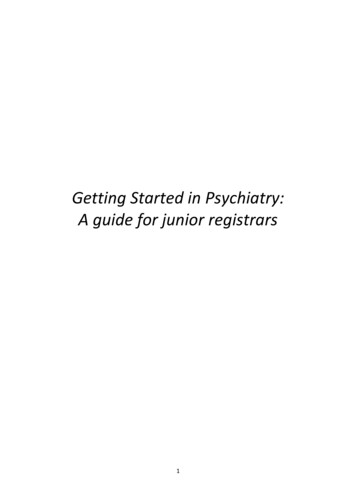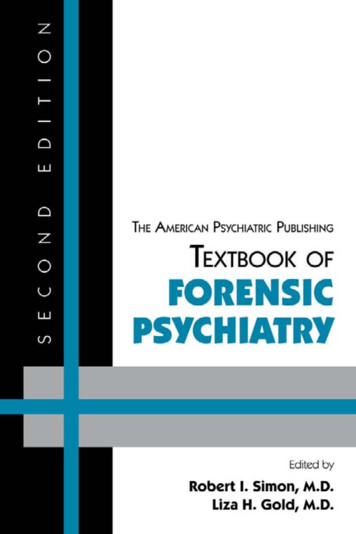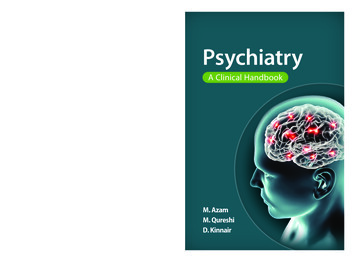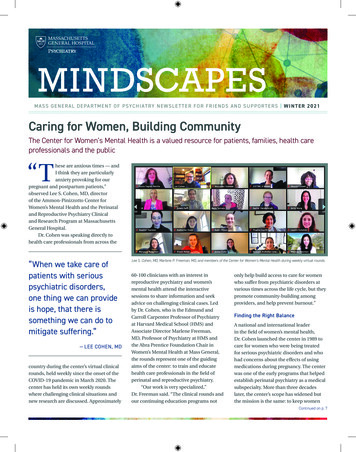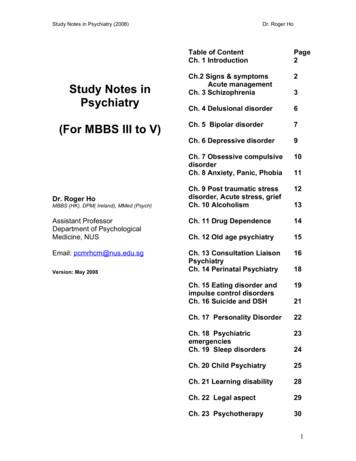
Transcription
THE AMERICAN JOURNAL OFPSYCHIATRYRESIDENTS JOURNAL’December 20142InsideVolume 9Issue 12In This IssueMental Illness and MassViolenceIjeoma Chukwu, M.D., M.P.H.3Mental Illness and MassShootings: Where PublicMisperception Ends andPsychiatry BeginsKatherine S. Pier, M.D.6The Insanity Defense andViolent CrimesMorgyn E. Beckman, M.D.9Not Guilty by Reason ofInsanity: A ControversialDefenseNeeral Kamlesh Sheth, D.O.11Urethral Self-Injury: A CaseReportOliver C. Joseph, M.D.13On the Right Side of History:Mental Health and StateViolenceMarco A. Ramos, B.A.Michael D. Alpert, M.D.14The Nazi and the Psychiatrist:Hermann Göring, Dr. DouglasM. Kelley, and a Fatal Meetingof Minds at the End of WWIIReview by Matthew J. Baker, D.O.16Residents’ ResourcesEditor-in-ChiefMisty Richards, M.D., M.S.Senior Deputy EditorRajiv Radhakrishnan, M.B.B.S., M.D.Deputy EditorTobias Wasser, M.D.Guest Section EditorIjeoma Chukwu, M.D., M.P.H.This month’s issue of the Residents’ Journal focuses on the topic of violence and mentalhealth. In an editorial, Ijeoma Chukwu, M.D., M.P.H., provides an overview of mental illness and mass violence. In a review article, Katherine S. Pier, M.D., examines thepublic perception of mental illness and recent mass shootings, emphasizing the role ofpsychiatrists in shaping the public dialogue. Morgyn E. Beckman, M.D., explores therelationship between the insanity defense and violent crimes. Neeral Kamlesh Sheth,D.O., further assesses the not guilty by reason of insanity defense in a research articlethat includes historical development and forensic evaluation. In a case report, Oliver C.Joseph, M.D., discusses self-injurious behavior in a teenager with a history of comorbidmental illnesses, who acted out violently during his hospital stay. Marco A. Ramos, B.A.,and Michael D. Alpert, M.D., comment on the historical role of mental health professionals with regard to the controversial subject of state violence, highlighting the needfor training based in the social sciences, such as education in military medical ethicsand human rights. Lastly, Matthew J. Baker, D.O., presents his review of the book TheNazi and the Psychiatrist: Hermann Göring, Dr. Douglas M. Kelley, and a Fatal Meeting ofMinds at the End of WWII.Associate EditorsIjeoma Chukwu, M.D., M.P.H.Kathleen Mary Patchan, M.D.Media EditorHolly S. Peek, M.D., M.P.H.Staff EditorAngela MooreEditors EmeritiSarah B. Johnson, M.D.Molly McVoy, M.D.Joseph M. Cerimele, M.D.Sarah M. Fayad, M.D.Monifa Seawell, M.D.Arshya Vahabzadeh, M.D.
HOMEPREVIOUSNEXTEditorialMental Illness and Mass ViolenceIjeoma Chukwu, M.D., M.P.H.Associate EditorRecent media coverage in the aftermathof mass shootings has focused on the relationship between mental health andviolence. Perpetrators of mass violenceare often portrayed as mentally ill andtormented individuals with disturbedchildhoods. These views are reflected inthe public perception of mass shooters,according to the results of a national survey conducted by Barry et al. (1), whichdemonstrated that of 1,530 respondents,50% supported the belief that individuals with severe mental illnesses posea greater risk for violence than thosewithout mental illness. However, acts ofmass violence are statistically rare events,and, contrary to public perception, studies have found that the vast majority ofthese acts are perpetrated by individuals with no history of mental illness (2).According to Fazel and Grann (3), violent acts committed by individuals withmental illness account for as little as 4%of all violent crimes in the United States.Furthermore, there is evidence to suggest that the mentally ill are more likelyto be the victims of violent crime ratherthan the perpetrators (4).While the mentally ill are responsible foronly a small percentage of violent crimesin the United States, findings from several studies demonstrate that individualswith specific types of mental illness have agreater propensity for violence comparedwith the general population. Results fromthe National Institute of Mental HealthEpidemiologic Catchment Area Studyfound that the lifetime prevalence of violence was 16% among individuals withbipolar disorder and schizophrenia, compared with 7% in the general population(4). The lifetime prevalence of violenceThe Residents’ JournalPerpetrators ofmass violence areoften portrayedas mentally illand tormentedindividualswith disturbedchildhoods.among those with anxiety disorders wasfound to be comparable to the rates inthe general population. Study participants with substance use disorders in theabsence of mental illness had a lifetimeprevalence of violence that was seventimes that of individuals with seriousmental illnesses such as bipolar disorderand schizophrenia (4). More recent findings from the National EpidemiologicalSurvey on Alcohol and Other RelatedConditions demonstrated that severemental illness alone predicts only a modest increase in the risk of violence whencompared with the risk in the generalpopulation. When participants with comorbid mental illness and substance usedisorders were examined, results revealedthat these individuals had a much greaterpropensity for violence than the generalpublic, suggesting that substance abuseis a far greater predictor of violence thanmental illness alone (5).The findings from these studies underscore the need to focus violenceprevention efforts on substance abusetreatment. Several studies have associated a significant reduction in violencerisk with substance abuse treatment. Although there are high rates of substanceuse among the mentally ill, efforts to address substance abuse in this segment ofthe population are unlikely to significantly impact the incidence of violentcrimes, as those with mental illness onlyaccount for a small percentage of the perpetrators of such crimes. Drawing fromthis conclusion, the relationship betweenmental illness and violence in the media isperhaps grossly exaggerated, and violencereduction efforts may be more impactfulin the general population.Dr. Chukwu is a third-year resident in theDepartment of Psychiatry and Human Behavior, University of California, IrvineMedical Center, Orange, Calif., as well as anAssociate Editor of the Residents’ Journal.References1. Barry CL, McGinty EE, Vernick JS, et al:Perspective after Newtown: public opinion on gun policy and mental illness. NewEngl J Med 2013; 368:1077–10812. Institute of Medicine: Improving theQuality of Health Care for Mental andSubstance-Use Conditions. Washington,DC, Institute of Medicine, 20063. Fazel S, Grann M: The population impactof severe mental illness on violent crime.Am J Psychiatry 2006; 163:1397–14034. Friedman RA: In gun debate: a misguidedfocus on mental illness. New York Times,Dec, 17, 20125. Vandorn R, Volavka J: Mental disorderand violence: is there a relationship beyond substance abuse? Soc PsychiatryPsychiatr Epidemiol 2012; 47:487–5032
HOMEPREVIOUSNEXTMental Illness and Mass Shootings: WherePublic Misperception Ends and Psychiatry BeginsKatherine S. Pier, M.D.In the last 15 years, the frequency of masshomicides has accelerated, with mentalillness becoming a focus of recent discussion. Just as the terror and wounds ofone shooting begin to heal, the havoc repeats itself. The Columbine shootings of1999 and the massacre at Virginia Techin 2007 were among the early eventsthat contributed to a kind of communalhypervigilance, which has since sweptthrough American society. Panic ensuedafter Adam Lanza, a seemingly benignyoung man, shot his mother at home before decimating 26 others at Sandy HookElementary School and committingsuicide. Elliott Rodgers’ shootings in California and Ivan Lopez’s murders in FortHood, Texas, punctuate 2014. These masshomicides are entrenched in the American story and part of a collective memorythat will never be erased.In not-so-quiet desperation, the public attempts to fill the unknowns withplausible narratives. Since many violentperpetrators have been treated for mentalillness, our field is under scrutiny. What,if anything, could we have done to prevent the violence? How will we interveneto ensure the cycle ends? The present review on the association between mentalillness and violence, as well as potentialinterventions, raises as many questions asanswers.Although studies vary in their estimations, it is clear that mental illnessalone is not synonymous with violence(1–2). Fazel and Grann (3) used Sweden’s hospital registry to explore therate of violence attributable to severemental illness, defined as schizophrenia and other psychotic conditions.Within a 13-year follow-up period, theauthors studied population-attributable risk fractions. A total of 5.2% ofviolent offense convictions were attributable to a cohort of 98,082 patientsdischarged from inpatient psychiatricfacilities with diagnoses of psychoticdisorders. Among the violent crimesThe Residents’ Journalfor which they were convicted, thesepatients’ contribution to attempted orcompleted homicide was 18%. The limitations of the study are acknowledged.Patients with comorbid substance use,for example, were included in the studied cohort. The literature emphasizesthat substance use is the most reliablerisk factor for violence, independent ofand comorbid with other psychiatricdiagnoses (1, 4–7). Since patients withpsychiatric illness have a greater propensity for substance use (8–10), it isdifficult to say whether these offenseswould have taken place in the absenceof intoxication. Furthermore, all of thepatients studied had been under inpatient psychiatric care and carried clearpsychiatric diagnoses, which was notnecessarily the case for all those whohave committed acts of mass violencein the United States. Finally, the generalizability of these data to the UnitedStates is limited due to the higher homicide rates and liberal gun ownershiplaws in the United States (11).Gun ownership is constitutionallyprotected in our culture, rendering legislative initiatives that impinge on thiscivil liberty slow to develop. Out of theBrady Handgun Violence PreventionAct of 1993, which mandated background checks for Americans to legallypurchase handguns, evolved the National Instant Criminal BackgroundCheck System, a computerized systemlaunched by the Federal Bureau of Investigations (12). Those prohibited frompurchasing guns based on the NationalInstant Criminal Background CheckSystem include persons “adjudicated asa mental defective or committed to amental institution (13).” The languagehere is by all measures vague. It is unclear who, by these criteria, is “mentallydefective”; furthermore, many peoplewho may have serious mental illness donot pass through the doors of our mentalinstitutions.Legislation since 2012 has attemptedto further restrict access to firearmsamong persons with mental illness. In2013, Governor Andrew Cuomo passedthe New York Secure Ammunition andFirearms Enforcement Act, requiringmental health professionals to report thenames and personal information of patients deemed likely to seriously harmthemselves or others to local mentalhealth authorities. The information isthen checked against a database of stategun licenses, and if a match is found,the gun license may be suspended, andpolice may be authorized to find theindividual and remove the person’s firearm (14). The Secure Ammunition andFirearms Enforcement Act poses tremendous pressure on mental healthproviders, who may over- or under-report their patients because of clinicalthresholds that vary based on experienceand personal bias.A randomized controlled trial bySwanson et al. (15), published in 2000,investigated the role of involuntaryoutpatient commitment in reducingviolence among severely mentally illpatients. The study used a baseline sample of 331 involuntarily hospitalizedpatients who met criteria for involuntary outpatient commitment in NorthCarolina. The criteria are serious mental illness and “mental status limiting aperson’s ability to seek or comply voluntarily with treatment, and the likelihoodthat without treatment the person wouldpredictably decompensate to a point ofdangerousness or grave disability” (15).The cohort members were randomly assigned to outpatient commitment witha caseworker or to release with a caseworker. Among patients with a historyof violence, the 12-month recidivismrate was 48% in the control group and24% in the extended (more than 6months) outpatient commitment group.During the follow-up year, the investigators found that 50% of patients who3
HOMEcontinued to misuse substances wereviolent, compared with 26.5% of patients who abstained. A total of 41.6%of patients who were not adherent withprescribed medications were violent,compared with 25.5% who did adhere.This was measured using Fisher’s exacttest, as well as using two-tailed p values 0.001 and 0.05 for substancemisuse and medication nonadherence,respectively. Involuntary outpatientcommitment increased adherence anddecreased substance use. The authorsnoted the limitations of the study. Thestudy was not blinded; the populationmay not be generalizable; and the follow-up period was short. However, thestudy was well designed to examine theeffect of involuntary outpatient commitment on reducing violence. It alsoproposed that increased medicationadherence and decreased substance useare mechanisms by which such programs may mitigate violence amongthe mentally ill.As mental health providers, we are leftwith the question of whether thesedata can be extrapolated to perpetrators of high-profile mass shootings,many of whom had no previous historyof substance use or violence. Involuntary outpatient commitment mighthelp a subsection of severely mentallyill patients with a history of violencebut would not have prevented the Columbine and Virginia Tech shootingsor the shooting at Sandy Hook Elementary School.Tarasoff ’s Law (16), first passed bythe California Supreme Court in 1974and modified in 1976, was among thefirst laws to encroach on physicianpatient confidentiality. This law states:“When a therapist determines thathis patient presents a serious dangerof violence to another, he incurs anobligation to use reasonable care toprotect the intended victim againstsuch danger” (16). At present, over 20states “have statutes in which the dutyto protect is clearly defined” (17), although statutes vary between states.In Ohio, for example, clinicians areallowed to breach confidentiality consistent with their duty to protect butare not mandated to do so (17).The Residents’ JournalPredictably, Tarasoff ’s Law and subsequent legislation, such as the SecureAmmunition and Firearms Enforcement Act, have stirred controversy andfear. What has happened to patientconfidentiality or clinical judgment?It takes courage to seek help from amental health provider. If the mentally ill fear that their names will beentered into a nebulous database,might this further dissuade them fromseeking treatment? Will patients whoknow about the Secure Ammunition and Firearms Enforcement Actreport suicidal or homicidal fantasies? Furthermore, a patient can easilycross state lines or go to a private gunsalesperson if he or she is determinedto find a weapon. In 1987, the APACouncil on Psychiatry and the Law(18) issued a statement asserting thatphysicians will not be liable if theybreach confidentiality when a patienthas made an explicit threat and thereis a reasonably identifiable victim. TheAPA further stipulates that the physician is protected so long as he or sheacts similarly to another “reasonablyprudent physician under the same circumstances.” This implores providersto air on the side of over-reporting,which may threaten the therapeuticalliance.Despite the flaws of the Tarasoff Lawand the Secure Ammunition and Firearms Enforcement Act, they have thepotential of reminding mental healthproviders to ask about violence andsuicide, to educate family membersabout safeguarding firearms, and tocollaborate with other professionalsin the face of ambiguity. Addressingthese modifiable risk factors while aperson is under psychiatric care may bethe most important intervention of all.Following the Elliott Rodger shooting on the University of California,Santa Barbara campus, Watson andJones (19) wrote on “the clear andconsistent connection between massshooting incidents and [selective serotonin reuptake inhibitor] drugs” (19).The public rhetoric has increasinglyfocused on the psychopathology ofthe perpetrators. The Fort Hood gunman Ivan Lopez had posttraumaticPREVIOUSNEXTstress disorder. Elliot Rodger madeconcerning statements on Facebookthat revealed his mental state at thetime he carried out the mass shooting.Adam Lanza reportedly had obsessivecompulsive disorder and Asperger’ssyndrome. Society has asked why psychiatrists cannot treat these illnessesmore effectively. How could physiciansallow such individuals to commit theseacts of terror? These recent shootingsplace an enormous burden of responsibility on psychiatrists to mitigate riskwithout much evidence. However, ifwe do not help shape this dialogue, wemay implicitly place our profession atrisk, while allowing public misperception to further stigmatize our patients.Dr. Pier is a second-year resident in theDepartment of Psychiatry, Icahn School ofMedicine at Mount Sinai, New York.The author thanks Nancy Glickenhaus, J.D.,L.M.S.W., and Tobias Wasser, M.D., fortheir editorial advice, curiosity, and supportin assisting with this article. The author alsothanks Dr. Samuel J. Langer for helping tofoster interest in this topic.References1. Swanson JW, Holzer C, Ganju V, Jono R:Violence and psychiatric disorder andpsychiatric disorder in the community:evidence from Epidemiologic CatchmentArea surveys. Hosp Community Psychiatry 1990; 41:761–7702. Friedman R, Michels R: How should thepsychiatric profession respond to the recent mass killings? Am J Psychiatry 2003;170:455–4583. Fazel S, Grann M: The population impactof severe mental illness on violent crime.Am J Psychiatry 2006; 163:1397–14034. Swanson JW, Borum R, Swartz MS, et al:Psychotic symptoms and disorders andthe risk of violent behavior in the community. Crim Behav Ment Health 1996;6:309–3295. Wallace C, Mullen PE, Burgess P: Criminal offending in schizophrenia over a25-year period marked by dein sti tu tionalization and increasing prevalenceof comorbid substance use disorders. AmJ Psychiatry 2004; 161:716–7276. Swartz MS, Swanson JW, Hiday VA, et al:Violence and severe mental illness: the effects of substance abuse and nonadher-4
HOMEence to medication. Am J Psychiatry 1998;155:226–2317. Monahan J: Mental disorder and violentbehavior perceptions and evidence. AmPsychol 1992; 47:511–5218. Mueser KT, Yarnold PR, Bellack AS: Diagnostic and demographic correlates ofsubstance abuse in schizophrenia and major affective disorder. Acta PsychiatrScand 1992; 85:48–559. Pope HG: Drug abuse and psychopathology. N Engl J Med 1979; 301:1341–134310. Khantzian EJ: The self-medication hypothesis of addictive disorders: focus onheroin and cocaine dependence. Am JPsychiatry 1985; 142:1259–126411. Barry CL, McGinty EE, Vernick JS, et al:After Newtown: public opinion on gunpolicy and mental illness. N Eng J Med2013; 368:1077–108112. Hall RW, Friedman SH: Guns, schools,and mental illness: potential concerns forphysicians and mental health professionals. Mayo Clin Proc 2013; 88:1272–128313. Department of Justice: National InstantCriminal Background Check System.Washington, DC, US Department of Justice, Federal Bureau of Investigations, - infor mation/nics-in dex- brochure14. Swanson JW: Mental illness and new gunlaw reforms: the promise and peril of crisisdriven policy. JAMA 2013; 304: 1233–123415. Swanson JW, Swartz MS, Borum R, et al:Involuntary outpatient commitment andreduction of violent behavior in personsPREVIOUSNEXTwith severe mental illness. Br J Psychiatry2000; 176:324–33116. Tarasoff v Regents of the University ofCalifornia, 551 P2nd 334 (Cal 1976)17. Anfang SA, Appelbaum PS: Twenty yearsafter Tarasoff: reviewing the duty to protect. Harvard Rev Psychiatry 1996;4:67–7618. Appelbaum PS, Zonana H, Bonnie R, etal: Statutory approaches to limiting psychiatrists’ liability for their patients’ violent acts. Am J Psychiatry 1989;146:821–82819. Watson PJ, Jones A: Army admits FortHood shooter was on psychiatric drugs.http://zwww.infowars.com/army-ad mits- g a Career in PSYCHIATRYThis two-part guide is designed to help medical students, residents, fellows,and early-career physicians successfully prepare for the transition points:Part 1Part 2Medical School and ResidencyTransitioning to PracticeNavigating the Transition to Residency Choosing a Residency Program The Residency Application Process Choosing Wisely—Assessing PracticeOptions and Demographic LocationsPsychiatry Residency Competencies in Psychiatry Subspecialties and Research TrainingBoard Certification Process andRequirements Entering Into a Physician EmploymentAgreement What is Integrated Care? Writing Your Business Plan Building Your Practice Through Marketingwww.psychiatry.org/residentsThe Residents’ Journal5
HOMEPREVIOUSNEXTThe Insanity Defense and Violent CrimesMorgyn E. Beckman, M.D.In 1991, Callahan et al. (1) reviewed 8,979insanity defense cases and found that acquittees were more likely to have seriousmental illness and to have committedmore serious offenses compared with defendants who were convicted. Successfulnot guilty by reason of insanity acquittees were more likely to be older, female,and single, as well as more educated. Justover one-half of those individuals pleading not guilty by reason of insanity and84% of those acquitted under the notguilty by reason of insanity defense hadschizophrenia, other psychosis, or an affective disorder. Numerous studies havebeen completed in the years since regarding the relationship between the insanitydefense and violent crime.MethodThe present article is a review of theliterature from 1994 to 2014 on the relationship between the insanity defenseand violent crimes. PUBMED, EMBASE, and PsychINFO were searchedusing the following terms: (violence ORcrime) AND (mental illness OR mentaldisease) AND (insanity). Eighteen of 91articles meeting search criteria were chosen based on their inclusion of data onmental health and violent crime or characteristics of persons pleading and/oracquitted under the not guilty by reasonof insanity defense.General Mental Illnessand Violent CrimeThe literature included several articlesabout the relationship between mentalillness and violent offenses. Fazel andGrann (2) examined the psychiatric diagnoses of homicide defendants in Sweden.Ninety percent had a psychiatric diagnosis, most commonly psychotic disorder(20%), followed by substance use disorder(19.7%). Tiihonen et al. (3) found thatwhen mental illness was involved, violentcrimes were most frequently perpetratedby male offenders with alcohol-inducedpsychoses or schizophrenia with concurThe Residents’ Journalrent substance abuse. Swartz et al. (4)echoed the finding that substance usesignificantly increased the risk of criminality. Controlling for substance abuseand personality disorders, Brennan et al.(5) found that persons with schizophrenia were significantly more likely to bearrested for criminal violence. Using datafrom persons discharged with a diagnosis of schizophrenia linked to Sweden’snational crime registry, Fazel and Grann(6) calculated that the expected crimerate would decrease by 5% if there wereno persons with schizophrenia in Sweden, or one in 20 violent crimes would beavoided.Lack of a national database has led tofewer U.S. studies (7). Martone et al. (8)examined the charts of 278 randomly selected homicide defendants. Defendantswere mostly young African Americanmales, and 58% had at least one axis I oraxis II disorder, most commonly a substance use disorder (47%). Swanson etal. (9) assessed patients for two levels ofviolent behavior: minor (assault withoutinjury or weapon use) and serious (assaultwith injury or lethal weapon, threat withlethal weapon in hand, or sexual assault).The 6-month prevalence for violence was19.1%, with 3.6% classified as serious.Positive psychotic symptoms increasedrisk for both levels, while negative symptoms lowered the risk of serious violence.Minor violence increased with substanceuse, younger age, female sex, and residingwith family. Serious violence increasedwith childhood conduct problems andvictimization.Elbogen and Johnson (10) investigatedresults from the National Epidemiologic Survey on Alcohol and RelatedConditions data. Offenders were morelikely to be young, male, less educated,and to have a history of violence and juvenile detention. Incidence of violencewas higher for persons with mentalillness, but when corrected for confounders, mental illness was a predictoronly for those with comorbid substanceuse. Severe mental illness did not in-dependently predict future violentbehavior, emphasizing the importanceof evaluating clinical, historical, andcontextual factors.Despite high rates of mental illness,inmates have rarely received effectivetreatment. Matejkowski et al. (11) reported a lack of mental health treatmentnoted in charts, suggesting that manyof the offenders in their study were notreceiving treatment or taking medications at the time of the crime. Fazel andGrann (2) reported that 53% of theirstudy sample had psychiatric diagnoses,but less than one-half had been hospitalized, with 8% receiving treatment inthe 3 months prior to the offense. Inthe Swartz et al. study (4), of the 331subjects awaiting outpatient commitment for severe mental illness, 71% hadnot taken their prescribed medicationin the 4 months prior to admission,suggesting that even with appropriatecare, many patients are nonadherent.Moreover, substance abuse and medication nonadherence were significantlyassociated with serious violent behaviorprior to hospitalization.Persons Found Not Guiltyby Reason of InsanityNot guilty by reason of insanity acquittees make up a small population, sinceonly 1% of felony cases use the not guiltyby reason of insanity defense, and approximately 26% of these result in an acquittal(1). Nielssen et al. (12) reported that 272offenders were found not guilty by reason of insanity of violent offenses over 17years in New South Wales. Twelve of the272 were determined to be manic at thetime of the offense, 10 had schizoaffectivedisorder, and two had a bipolar disorder.In another study, Nielssen et al. (13) compared persons with first-episode psychosisand previously treated persons with psychosis who were found to be not guiltyby reason of insanity for a violent offense.Schizophrenia was the most common diagnosis (86%), with 46% of cases being6
HOMEa first episode. Across studies, psychoticdisorders were the most common diagnosis. Novak et al. (14) reviewed records of42 sex offenders found to be not guilty byreason of insanity, identifying 67% withpsychotic disorders. Dirks-Linhorst andKondrat (15) examined not guilty by reason of insanity acquittees between 1980and 2007 in Missouri and reported similar findings: 85.8% were male; 69.6% wereCaucasian; 62.4% had psychosis; and 56%had a substance use disorder. A study ofArgentinian not guilty by reason of insanity acquittees (16) identified 26.6%with schizophrenia or other psychoticdisorders and 23.2% with substance usedisorders. Victims were known to theoffender in 58.9% of cases, and womenwere statistically overrepresented (16). ANew Zealand study conducted by Simpson et al. (17) also found proportionallymore female offenders, charged with homicide, who were acquitted under the notguilty by reason of insanity defense.Studies of women, particularly mothers,have increased recently given the increasein homicide of children. McKee andBramante (18) studied a sample of 80mothers in Italy who had attempted tokill or who had successfully killed one ormore of their children between 1967 and2003. Mothers who were found guiltyhad lower IQs, were less likely to havegraduated from high school, and morelikely to have divorced parents. Motherswho were found not guilty by reason ofinsanity were more likely to have a substance use diagnosis, previous psychiatrichospitalizations, suicide attempts, andprior attempt of child homicide.Ferranti et al. (19) compared female homicide offenders found not guilty byreason of insanity with male offenderscommitted to the same hospital. Womenwere more likely to have a mood component, with 52% meeting criteria forschizoaffective, depressive, or bipolardisorder. Psychotic disorders remainedthe most common diagnosis, with 60%having schizophrenia, schizoaffectivedisorder, or other psychotic disorders.Childhood physical and sexual abuse, aswell as intimate partner violence, weremore common among women, and theirvictims were more likely to be familymembers under age 18.The Residents’ JournalDiscussionResearch from the past two decades supports the findings of Callahan et al. (1)that a large percentage of violent crimescommitted by individuals with mentalillness were among those with psychoticdisorders (1). Future studies regardingcrimes committed by persons found to benot guilty by reason of insanity or pleading not guilty by reason of insanity areneeded. Researching a broader population provides updated demographic anddiagnostic information of those who areacquitted compared with those who arenot. Ferranti et al. (19) have provided agood starting point, which could be expanded by adding not guilty by reasonof insanity acquittees of all crimes andcomparing their sample to women withunsuccessful not guilty by reason of insanity defenses. Inmates are a highly guardedpopulation, causing study difficulties, andpossible sites for not guilty by reason ofinsanity studies produce only small sample sizes that lack sufficient statisticalpower. International studies lack generalizability due to a higher rate of violentcrime in the United S
PSYCHIATRY RESIDENTS' JOURNAL December 2014 Volume 9 Issue 12 Inside In This Issue 2 Mental Illness and Mass Violence Ijeoma Chukwu, M.D., M.P.H. 3 Mental Illness and Mass Shootings: Where Public Misperception Ends and Psychiatry Begins Katherine S. Pier, M.D. 6 The Insanity Defense and Violent Crimes Morgyn E. Beckman, M.D. 9 Not Guilty by .


